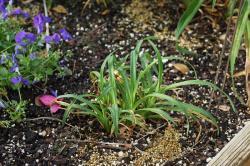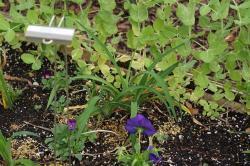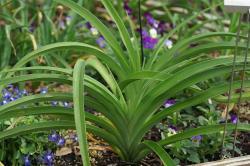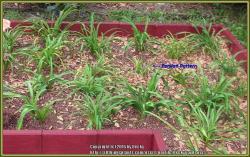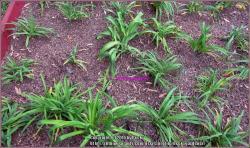@florange I do not expect to be able to change your mind but I must politely disagree completely with you about identifying "evergreen" from "dormant".
There is at least one major problem with the foliage registration categories of dormant/evergreen/semi-evergreen. They are biologically incorrect. Dormancy relates to growth versus non-growth and evergreen relates to how long a leaf lives (ie through winter). Asking someone to classify a daylily's foliage to dormant/evergreen/semi-evergreen is like asking someone to classify a pie's sweetness to hot/sweet/semi-sweet.
The correct foliage category is deciduous not "dormant". Being deciduous is unrelated to being dormant or requiring chilling or setting buds or being hardy.
When daylilies are registered as "dormant" they are biologically deciduous; they may also be biologically winter-dormant. When they are registered as "evergreen" or "semi-evergreen" they may be biologically winter-dormant or ever-growing. A simple comparison should help make this clear. A maple tree is deciduous; it loses all its leaves. It is dormant during winters in cold winter climates. A pine tree is evergreen; it keeps its leaves (needles) through winter. It is dormant during winters in cold winter climates. Neither grows during winter in cold winter climate locations. They are both dormant although one is deciduous and the other is evergreen. Daylilies can be dormant and deciduous or dormant and evergreen.
Dormancy
The current botanical definition of dormancy is "Dormancy is a temporary suspension of visible growth of any plant structure containing a meristem".
Dormancy applies basically to buds and within buds to the meristem (shoot apical meristem or meristem for short, known commonly as the growing point).
Dormancy is unrelated to the presence or absence of leaves ("going down"). The loss of leaves does not indicate when a daylily became dormant or even if it is actually dormant. It may be dormant, on the other hand it may not be dormant; it may be creating baby leaves but not sprouting them or not sprouting them above the soil surface. The only certain way to know when buds or meristems are dormant is by slicing through samples of them and examining them under a microscope over a period of time. One may be able to get some idea of whether a bud is dormant by watching to see if new baby leaves are produced continuously over time but one cannot be certain one is correct.
Botanically dormancy is divided into three types:
1) ecodormancy - where the bud or meristem is not growing because of some factor in the environment (the growing conditions). All daylilies can be ecodormant. As an example, when it is too cold the daylily does not grow. A plant may or may not have enough time to form a bud when it stops growing due to ecodormancy.
2) paradormancy - where the bud or meristem is not growing because of some factor in the plant but outside of the bud itself. Apical dominance of an axillary bud (nestled between a leaf and the stem) would be one example of paradormancy. Most gardeners know that pinching off the growing point/tip will often cause lateral/axillary buds to sprout and produce branches. This is an example of paradormancy.
3) endodormancy - where the bud or meristem is not growing due to factors within the bud or more precisely within the meristem. This is the type of dormancy that we think of as being present in the autumn that prevents tree buds from sprouting and that can only be removed when the bud experiences enough cold (chilling hours or units).
Only endodormant buds or meristems require chilling to sprout or grow again.
All daylilies can be dormant - whether they are deciduous (incorrectly registered as 'dormant'), evergreen or semi-evergreen. The evidence for this is present in every garden with daylilies that has all three registered categories and that is far north enough. I am in zone 4. I do not check foliage type when I order daylilies from the southern US or California. I grow between 600-800 registered daylilies. Since I don't check registered foliage type I do not know what percentages of each type I grow but it is probably more evergreen and semi-evergreen than registered 'dormant' (I do not have a listing of the daylilies I grow). They all are dormant during winter. Nearly all form buds. I estimate that less than a dozen appear to be caught by winter (extreme low temperature) too quickly to form a bud.
I am going to describe an imaginary situation. Supposing instead of buying all the registered daylilies that I grow, I had hybridized them all here. I would have registered them all as dormant (because they set buds and stop growing). Now say I took one hundred of those daylilies and divided their clumps so that I had 10 sets of one hundred. Then say I gave one set of 100 to each of 10 gardeners from New York to Florida and asked them to classify each of the daylilies as to the registered foliage types dormant/evergreen/semi-evergreen. This is what I would expect to find. In the North the gardeners would classify more of the daylilies as dormant and fewer as evergreen. The further south the gardener, the more evergreens and the fewer dormants.
Going into winter, daylilies could be endodormant or ecodormant (we will ignore paradormancy). In both cases they are not growing. In both cases they may have set buds or not set buds. If they are ecodormant they have presumably become ecodormant when they experienced the low temperatures that make them ecodormant. Those low temperatures would differ for each cultivar. When or if that low temperature is reached for a particular cultivar would depend on the location that it is grown in. If they are endodormant then they may have become endodormant when they experienced the day-length/night-length that makes them endodormant or the low temperature that makes them endodormant or they become endodormant completely autonomously or they require some combination of factors. If they are endodormant then only if photoperiod or an autonomous method sets the endormancy would they become endodormant at the same time in different locations.
No daylily is currently known to be endodormant in the autumn. Daylilies are known to be ecodormant in the autumn and to have set buds.
It is relatively easy to check the type of dormancy being shown by a plant. Stout did this for a number of his plants in November in New York - they were all ecodormant. I have checked it for those daylilies that have been identified to me as "hard" dormants. I have checked some of those daylilies in December, November and October. They were all ecodormant. I have checked some daylilies that I received in September but that I do not know whether they were dug in August or September. They were all ecodormant. I continue to look for and test daylilies that might be endodormant.
Plant species that are endodormant in autumn typically go through three phases. They are paradormant, then they become endodormant and finally they become ecodormant. They typically have buds in late summer. Those buds do not sprout before winter because they are endodormant. They sprout the next spring when they are ecodormant. Endodormancy prevents the buds from sprouting at the wrong time of the year - the autumn.
Daylilies do not do this. They tend to sprout in the autumn. Different cultivars tend to sprout at different times and grow at different rates in the autumn. Some daylilies seem to not sprout - or at least their buds may or may not appear above the soil surface. However, that may depend on where they are grown and how they are grown. It almost certainly will depend on temperatures and may also depend on day-lengths. Unfortunately, there may be no real difference between a cultivar whose bud does not appear above the soil surface (or which takes a long time to appear above the soil surface) and one whose bud does appear above the soil surface. The only difference may be that one may grow faster and at lower temperatures than the other. One would need to measure the height that buds sprouted both above and below the soil surface (or in total - disregarding any effect of the soil surface making it difficult to see how much a bud had actually sprouted). The figure below shows what one should see if there is a potential difference between those cultivars that have not sprouted above the soil surface on any given date versus those that have.
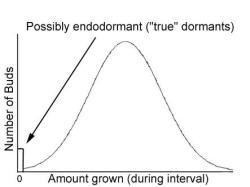
In the figure there are cultivars that have not shown any bud growth during some period of time (they appear to be dormant - not growing). If they simply are one end of the tail of the amount grown then the number of such cultivars will be as expected for the shape of the distribution. However, if they are in some way different from the other cultivars then as a group they will not be present in the numbers expected (based on the growth of all the other cultivars). If one did such an analysis on daylily bud growth in the autumn one then could also test those cultivars to see if in fact they did not grow when given good growing conditions at that time (autumn) and see if they were endodormant.
